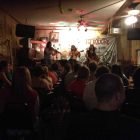The Modern Bookstore: An Interview with St. Mark’s BookShop Co-Owners Bob Contant and Terry McCoy
I remember the first time I went to St. Mark’s Bookshop. I had just skipped out of an orientation session my first week of freshman year at NYU, and decided to explore the area by myself. It was the first time I was walking New York’s vibrant streets alone, a thousand miles away from my family, only blocks away from places that I had only read about in books: the Met from Claudia and Jamie Kincaid, Si Morley’s Dakota Apartment House, and Piri Thomas’s “I’m here, and I want recognition” mentality. I wanted to get sucked up by the city, get lost in its Venetian labyrinth, witness the “fairy city made of silver cardboard” that Betty Smith described so evocatively in A Tree Grows in Brooklyn.
I sat on a curb and watched a group of upperclassmen push the Astor Place Cube’s eighteen hundred pounds with ease. I ate a falafel from Mamoun’s (back when it was under two dollars), next to a homeless man playing a ukelele with only one string. I watched a rainbow array of hair colors strut down St. Mark’s runway and a group of young kids freestyle rap as a used record store owner blasted the New York Dolls from his helter-skelter mausoleum to decades past.
I stumbled into a bookstore on Third Avenue, narrowly averting a large mass of my fellow classmates returning from our orientation. My first impression as I walked through its double doors was that I had just entered a friend’s personal library. There were no Dan Browns or Mitch Alborns to be found; instead, high shelves and sections with labels like ART MONOGRAPHS and ANARCHY. In the back a section of pamphlets and booklets from local writers on consignment, a collection of musings and photographs, a small window into the community that I soon found surrounded St. Mark’s Bookshop and its co-owners, Bob Contant and Terry McCoy.
I no longer live in the East Village, but whenever I am in the area I always find time to stop in. It may not be the cheapest, but it’s always been easy to browse and never fails to provide me with a a few surprises.
I spoke with Contant and McCoy a few months ago after its recent crowd-funding effort. No doubt you have read many of the reports detailing the store’s woes—raised rent, dropping sales, staff layoffs, and an insurmountable debt—but what’s miraculous is the store’s—and neighbors’s—refusal to step down.
Bob Contant: Our first location, which was at 13 St. Mark’s Place, was $375 a month. Everything’s relative, but that was still cheap.
Justin Alvarez: Why’d you move?
Bob Contant: It was a small store, and we had the opportunity to move across the street to 12 St. Mark’s, which was considerably larger with a lot more space. And then we had an opportunity to move here five years ago because Cooper Union actually solicited us. They had this new dormitory building, and they were concerned that the community board would be upset over a new high-rise in the neighborhood. More of this corridor on Third Avenue is becoming high-rises.
Terry McCoy: Cooper Union has a lot of the same neighborhood issues that New York University has. The neighborhood is always on guard against its development plans.
BC: To ward off any criticisms, Cooper Union solicited us a fifteen-year lease at twenty percent less than what we were paying on St. Mark’s Place. We jumped at the chance. Plus it was a bigger space. We had help from an investor at the time to make that move; otherwise, it wouldn’t have been possible. And it worked out great for us for the duration of the lease. It only became a problem when we had to re-up the lease fifteen years later, which is now five years ago. There’s a whole new administration at Cooper Union. All the people we worked with are no longer there—they’ve all retired and moved on. The people there now are looking at the bottom line, and they’re saying we’re broke and we need every nickel we can. They made it untenable for a bookstore to pay the rent, and that’s the situation we’re in. We’re trying to think of either different ways to generate more income out of the store or move, and that’s a dilemma for us.
JA: What are some of your ideas to generate more income?
TC: Renting out the basement and moving our offices upstairs, which Cooper Union will allow us to do.
BC: Also, starting a textbook service for Cooper Union as there’s no Cooper Union bookstore. We’ve talked to Cooper Union about this idea, and it’s not really gotten any traction, but we have a third party that we’re talking to that does textbooks. Maybe we’ll be able to work something out, have someone come in to run that business here. These are all ideas that we’re back and forth on everyday because it’s hard to analyze how much money is involved when you haven’t done something before.
TC: Bob and I don’t know the textbook business at all. It’s a whole different business really. However, if they have the talent—or at least borrow the talent—that’s the kind of thing we’re racking our brains over everyday.
BC: You know, we’ve always maintained a classical ambiance, in terms of books. We have over two thousand periodicals that run the gamut of fashion, politics, literature, international, etc. Those periodicals are a great sideline, and the only other sideline we have is a couple racks of greeting cards that are not from major manufacturers … they’re hand-designed.
JA: From the community?
BC: Yes. We also sell DVDS that tend to be literary or political, and we’ve had some success with that. People also tell us that we should be selling coffee mugs. I’ve noticed that the Strand now has a candy bar, and they sell action figures. That’s the kind of stuff that doesn’t make it seem like a bookstore.
JA: Afraid you’ll cheapen…?
BC: Right.
TM: We want to maximize the space, which we haven’t yet done, but we don’t want to cheapen the brand.
JA: What do you think about the East Village and its changes over the past couple of decades?
TM: Physically, it’s changed in the sense that, yes, when we first opened everybody who was involved with the store lived a few blocks from the store and we all had our own apartments where you could live by yourself. You know, you didn’t have to have roommates. That, of course, has changed hugely. However, there’s definitely a community supporting us. They’ve come out time and again. Last year when the rent issue was first publicized, we received a tremendous outpouring from the community. Jeremiah Moss rallied huge amounts of people with his petition.
JA: So, if you do move, would you stay in the area?
TM: That’s what we told the brokers.
BC: We want to stay in the East Village. We’ve been here for thirty-five years. We feel like we’re the neighborhood bookstore. And there really isn’t another bookstore but the Strand … We want to stay here. It’s our community.
TM: It’s part of our identity.
JA: What about Brooklyn and some of the claims that there is a stronger sense of community there versus Manhattan?
BC: What’s different between Brooklyn and Manhattan is that you have real neighborhoods in Brooklyn where people settle in. Manhattan is more of a transient neighborhood for young people, you know. If you’re in school or affiliated with a university, you don’t mind living in an apartment with two or three other people. This is not a place you’re settling down. You’re passing through, so to speak, and that’s what has changed. Back in the day, you never even ventured into Alphabet City. You just didn’t. These days, it’s so gentrified…
TM: A lot of expensive co-ops over there.
BC: It’s not the neighborhood for poor, struggling artists, which it always had been. No matter if you were a filmmaker, an artist, a writer, or theater person, you gravitated towards the East Village because it was community of like-minded souls. You could be poor here. I mean, we didn’t make that much money from the bookstore, so to speak. But, as Terry said, we both lived right near here. My first apartment cost me sixty-three dollars a month, and I moved up in the world by getting an apartment for one hundred twenty five dollars a month that had a fireplace and four rooms. You know, it was luxury. That world is gone now.
JA: What did you both do before the bookstore?
TM: I actually came to New York to be an actor. I had a couple of weird jobs before I got my bookstore job. I worked in bookstores on-and-off for three years. I was also a freelance proofreader and copyeditor—that’s what I was doing when we opened the store—but I met all the guys who we opened the bookstore with by working in books.
BC: I came to New York from Cambridge, Massachusetts, in ‘72. In Cambridge, I worked in libraries and a bookstore in Harvard Square. Every week we’d get the Village Voice, and there was always an ad from the East Side Bookstore for its ten best books. It was just this generic ad, but the books were always so interesting that we’d cannibalize the list and try to sell the same kind of books up in Harvard.
JA: Which bookstore did you work at?
BC: Paperback Booksmith. It was part of a chain up there. [Editor’s note: it’s now the Brookline Booksmith.] Actually, the store I worked at was open twenty-four hours, and it was a little hole-in-the-wall store before they expanded. It was an experience. There was only eight of us that worked there around-the-clock. The guy who worked the midnight to eight A. M. shift, he worked there with his German shepherd.
[laughs]
But, anyway, I used to see the ad for the East Side Bookstore, and I always wanted to come to New York. I went right there and applied for a job, but there wasn’t really anything. I got persistent. I mean, there were so many bookstores in New York. It was just amazing. I finally got a job at East Side Bookstore, and I met Terry there. The guy who was managing and running the store was who initially put the idea in our heads of having our own store and doing it for ourselves, because the owner of East Side Bookstore was an absentee owner. He was a schoolteacher, and would literally come in once a month to write checks … and that would be it.
We were all working hard to make a go of this little store on St. Mark’s Place, and we took the big leap and raised enough money to start our own store. We got this storefront, as I said before, for $375 a month. We did it as a collective initially. There were five of us for a little while, and one dropped out right away. Then, it was four of us for a long time. We benefitted enormously when Eli Wilentz’s Eighth Street Bookshop closed in 1980. He was very kind to us and gave us his entire mailing list. He donated bookcases and made it known that we were sort of the inheritors of what he was doing.
JA: The crown was being passed down.
BC: Right. Our growth also coincided with what was happening in the East Village–the whole punk scene, the art gallery scene. The East Village had been dead when we started, and now it was a boomtown.
JA: Were you part of the scene, or were you more of an outsider?
TM: We used to go to CBGB’s. We saw all those bands. I tell people–and it always amazes them–that when we used to go to CBGB’s you’d sit at a table. There was a little checkered tablecloth there and candles in a jar. We saw all those band—Ramones, Blondie, Talking Heads, Television. We were part of the scene in that sense, but we were not players. We knew people like Richard Hell, who was always a friend of the store. He used to sell books on consignment in those days.
JA: When do you think the area turned for the worse?
TM: I think things changed in the mid/late eighties. The Tompkins Square Park Riot. Everything got sour, you know. What Tompkins Square was really about was fear of gentrification, and that did come to pass. One of the reasons we wanted to get off St. Mark’s was we had such a problem with all the street book vendors. There was a time when St. Mark’s was known for them, they would line the street. The south side was a lot of art books, mostly stolen from our store. People would steal books from our store and sell them to one of the tables.
JA: It’s funny that a move around the corner could make such a difference.
TM: It did actually. It’s funny, but it did change it. By the nineties, in a way, the change was good. There was a business improvement across Eighth Street. It was part of the changing of the tone of the neighborhood. It wasn’t as free-wheeling, but we were thriving at that period of time. Even with the Barnes & Noble that opened in Astor Place, which set us back for a couple of years, even then we did okay. When things went really bad for us was the crash. It just happened instantly, that business declined.
JA: Do you think it’s because people saw books as an extraneous expense?
TM: That, and, I don’t know, people got less willing to use their credit cards. Also, they were beginning to market e-book readers.
JA: What are your thoughts on digital?
BC: People tell me they have e-readers, and they do their work on them. But, when they want to read a book, they come and buy a book. I think what’s most damaging for stores like us—and any independent bookstore—is Amazon, because what happens is kids come in with their iPhones, they can scan the bar codes of the book while they’re standing in the bookstore, and they order the book right here for a cheaper price. You know, on one hand, you can’t really blame them because they’re trying to save a buck; on the other hand, without a bookstore like this as a showcase, publishers are not going to be able to sell books because who’s going to know about them.
JA: Going back to you both working on the floor, has it brought back a resurgence of why you got into this business in the first place?
TM: It’s true. Before, we were spending most our days in the office.
BC: We now get to talk about books, which is one reason why we’re still in business.
TM: And the people. You know, it’s gratifying when someone asks for something and you’re able to tell them about something new. You know, everyone who was aware of the petition to save St. Mark’s Bookshop. when they come in now—and, unfortunately, our bookshelves are stretched thin—they always say, “Well, we’re glad you’re still here. I don’t know what I’d do without you.” These people continue to come in and buy books. We feel like we’re serving a real purpose. That’s the role of the independent bookstore now: to make these books available to people.
It’s the browsing experience. You come into a place, and you may have something in mind, but if you spend enough time you’ll probably find something else of interest as well. That’s what often happens.
JA: That’s what makes a good bookstore: where you find what you didn’t even know you needed.



